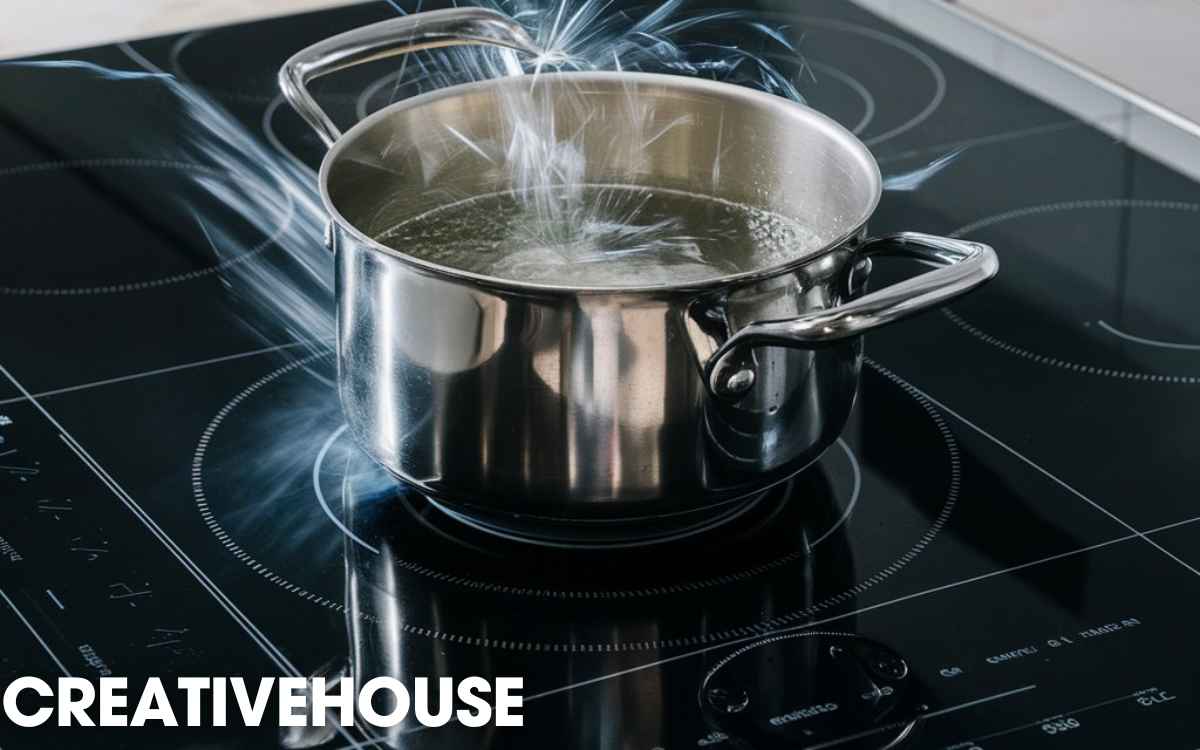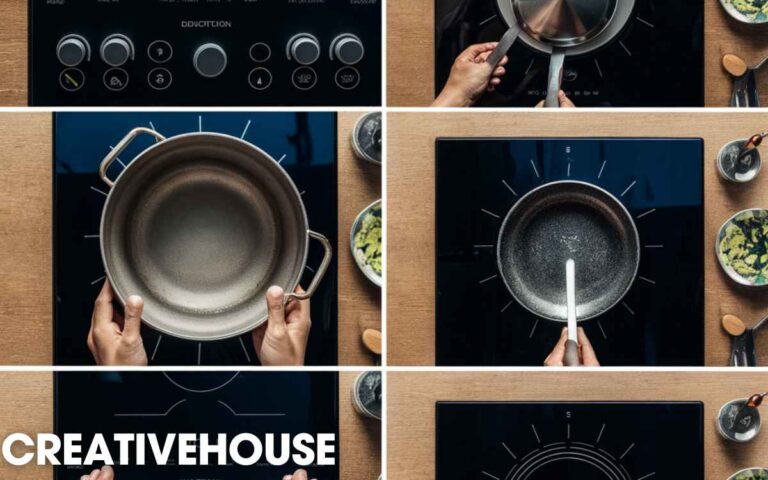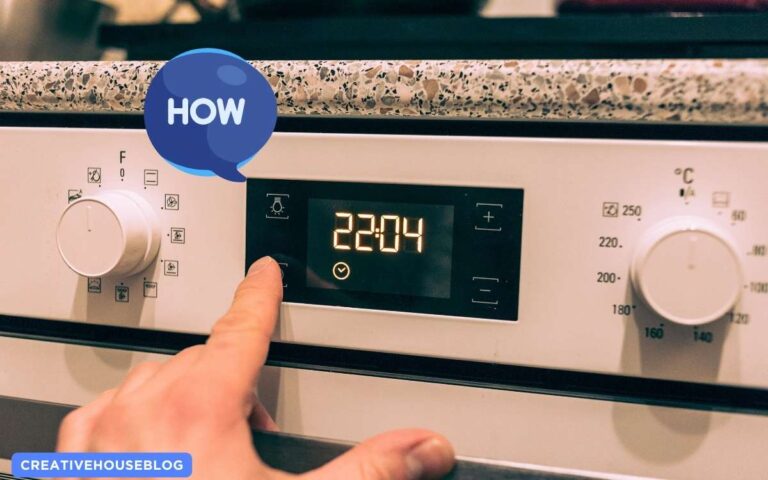Induction stoves work by creating an electromagnetic field around the coil. The process heats the cookware with the help of resistance force to reduce any redundancy in heating the stove and then the cookware.
If you have ever wondered “How does an electric stove work?” you are at the right place.
Key Takeaways

Induction Stoves and Electromagnetism: What is an Induction Stove?
Modern kitchens are all about efficiency. With the increasing utility costs anything that reduces the bills even slightly is worth considering.
Before diving into the nitty gritty of how does an induction stove work, the process needs a bit of explanation. The science behind induction cooktops:
Electromagnetic Fields
Electromagnetism, as the name suggests consists of electricity and magnetism. These phenomena are interconnected when it comes to induction stovetops.
When electric current flows through a wire, it builds a magnetic field around it. This is the foundation of the science behind these stoves.
Unlike traditional gas or electric stoves, the field directly affects the cookware. It does not heat up or transfer heat but generates the heat directly on the cookware.
Induction Stove Tops
Induction cooktops are revolutionary because of their efficiency and speed. An induction stove uses the principles of electromagnetism to generate heat.
The heating up does not necessarily happen on the stove. These require special cookware that heats up instead. Induction stoves do not have any heating elements either.
They feature a flat surface with marked circles where the pots and pans go. The surface remains cool to the touch while the cookware starts heating up. This increases the safety while you do all your cooking.
There are no knobs on an induction stove. These stoves have digital touch displays that control the heat and adjust it according to the setting.
How Does an Induction Stove Work?
You can summarize how an induction stove works in three distinct steps. I say three steps which may sound like it takes too much time to cook but it is the opposite.
Here is a detailed description of the steps to how does an induction stove work:
Magnetic Field
The first step is easy enough to understand. When you turn an induction stove on, an electric current passes through the coil. It is under the cooktop’s surface.
This current goes on to create a magnetic field around the coil. If you want to get technical, it is Ampere’s law.
(Source: Hyperphysics)
This creates an outward field that extends from the coil and around it. You can control the strength of this field with the touch controls on the stove. The strength of the field directly controls how much it heats the cookware.
The stronger the field, the more heat it produces on the cookware and the faster you get done with cooking.
Electrical Current Induction
The induction part of the stove happens on the cookware itself. You need special cookware for the stove to work its magic.
The pots or pans or whatever cookware you have needs to be of ferrous metal. Ferrous means any metal that contains iron. Some examples are stainless steel, alloy steel, and carbon steel.
(Source: Amazon)
When you put cookware made of these metals, the magnetic field interacts with it. It sends an electrical current within the cookware. This process is the electromagnetic induction.
The strength of the induction depends on how big the cookware is, what it is made of, and the electrical conductivity of the material. This also translates to how efficient the stove can be.
Heating the Cookware
Now comes the fun part which is the actual heating of the cookware. As the electrical current flows through the cookware, the material starts to create resistance.
This causes the metal to heat up. The heat is then transferred to what you are cooking inside the cookware via conduction and convection.
(Source: Chemicalslearning)
What induction stoves do differently than other types of stoves is that the cookware itself acts as the heat source.
Something to keep in mind is that the only cookware that works on induction stoves is ones that have magnetic properties.
If you want to know if your cookware is safe, get a kitchen magnet and hold it against the bottom of the cookware. As long as the bottom surface has magnetic properties, it will work.
Why You Should Switch to Induction Stoves: Pros of Using Induction Stoves
Induction cooktops are taking the market by storm. These stoves have several clear benefits over traditional gas and electric stoves.
Here are the benefits you can get from switching to induction stoves:
Speed and Efficiency
The main advantage of induction stoves over other cooktops is their speed. Induction cooktops heat up significantly faster than electric and gas burners.
This is because it gets rid of the energy loss that happens with other heating methods. When you turn the induction stove on, the heat is instantly generated within the cookware.
You do not have to wait for the burner to heat, then the cookware, and then the food. It works by eliminating the need for the stove itself to heat up.
Since there is no heat loss when the stove turns on, the energy efficiency becomes much more noteworthy. Direct heat transfer from the cookware to food is what makes the induction stoves worth it.
The heat loss is minimal to the environment and the efficient heat distribution lessens energy consumption. You will save a fortune on utility bills in the long run.
Precise Controls
When cooking, the accuracy of how much of each ingredient you use is very important. But how much heat you apply while cooking can also be important if you want the taste to be just right.
Induction cooktops provide precise temperature control, allowing you to cook with accuracy.
Unlike gas or electric burners, where heat is transferred from the burner to the cookware through conduction, induction cooking delivers heat directly to the cookware itself.
This direct heat transfer ensures that the temperature is consistent and uniform in every bit of the cooking process. You can easily adjust the heat levels with the touch controls.
Safety in The Kitchen
Induction cooktops stand out in many ways. But one of the most important is the safety it provides. Since the surface of the stove stays cool to the touch, accidental burns get thrown out the window.
The heat is only on the cookware so you can rest easy and not worry about touching hot surfaces. They also have built-in safety features that other stoves do not have.
If the burner is on without cookware on it, it does not heat up nor consume electricity.
Some models have automatic shut-off and overheating protection as well. These features heavily minimize the risk of kitchen accidents.
Easy Maintenance
Cleaning and maintaining an induction stove is a breeze compared to other stoves. Unlike gas stoves, there is no need to regularly clean the induction stove.
You do not even have to worry about coils or burner grates’ wearing and tearing. Induction cooktops have fewer parts that are prone to damage.
Good for The Environment
Environment-friendly appliances are the go-to nowadays. From big companies like Tesla and Ford to every small home appliance company, they all have one thing in common.
Which is to make their products leave the least amount of carbon footprint. On one hand, gas stoves emit greenhouse gases and pollute the indoor air to some extent. On the other, electric stoves use up a lot of energy.
Induction cooking releases less ambient heat into the room and has lower energy consumption out of all the stoves. By going induction, you can reduce the harm stoves cause to the environment and contribute to a healthier future.
Drawbacks of Induction Stoves
Even though induction stoves have their moment in the sun, they do have some flaws. Albeit not serious, but they are flaws nonetheless.
Here are some drawbacks to switching to induction stoves:
More Expensive Than the Other Stoves
The most important thing to consider when switching appliances is the budget and price you have to pay for it. The initial costs of getting an induction stove are relatively higher than other stoves.
And high-end models with safety or special features come with a hefty price tag. But the price is not just for show. Induction stoves are safer and reduce utility bills in the long run.
Induction stoves have longer lifespans compared to gas stoves which are prone to breaking down frequently.
While the average gas stove costs around 300 to 400$, a starter induction cooktop costs well over $1000.
Cookware Compatibility
Another reason why people tend to ignore induction stoves apart from the high price is cookware compatibility. As induction stoves need pots and pans made of ferrous metal, it gets hard to make your existing cookware work on them.
It becomes a huge waste of all the cookware you already have. Even though you trade them in for induction stove-compatible cookware at your local store, the money you have to add does not make it compelling.
Your trusty aluminum or copper cookware that you have for your gas stove will be useless for induction stoves. This is why it is important to consider these facts before switching over to induction stoves.
Is an Induction Stove the Right Choice for You?
Now that you know all about how does an induction stove work, you may be wondering if it is the right choice for you.
These are some important things you should consider when deciding on whether to get an induction stove:
- Cooking Style: If you enjoy fast cooking and with precision, an induction stove will fit right in. The speed and controls are best for busy home cooks who want to have food ready before they have to go out.
- Budget: As stated earlier, induction cooktops do not come cheap. So consider how much you are willing to spend on a stove.
- Installation and Space: If you want an induction range, you need a moderately large kitchen to accommodate it. The layout of your kitchen space is important in deciding which stove to get.
- Noise: Some people do not like the humming sound induction stoves make when they are on. If you have heightened senses and want a quieter kitchen, then you should not go into induction.
- Power Grid: Induction stoves are electric so you need a good circuit to push the power it needs. If you live in an area with frequent power outages, you should stay away from induction or even electric stoves. Unless you want to starve because you do not have a way to cook your food.
How Does an Induction Stove Work – (FAQs)
Is cookware made of cast iron good for induction stoves?
Cast iron has magnetic properties. They are good for use on induction stoves for frying or slow cooking.
Can you touch the induction stove surfaces while it is running?
An induction stove’s surface does not heat up so it is safe. It stays cool to the touch and there is no possibility of accidental burns.
What stove do chefs prefer?
Chefs love induction stoves and cooking on them because they can control the output more precisely.






